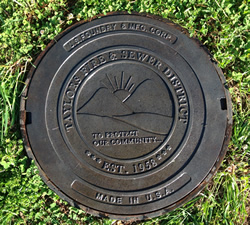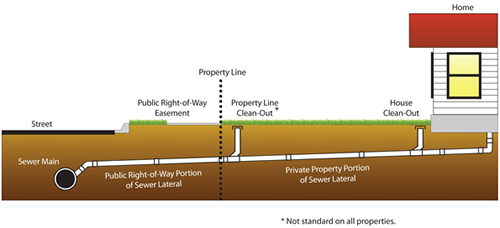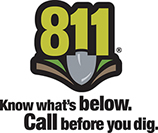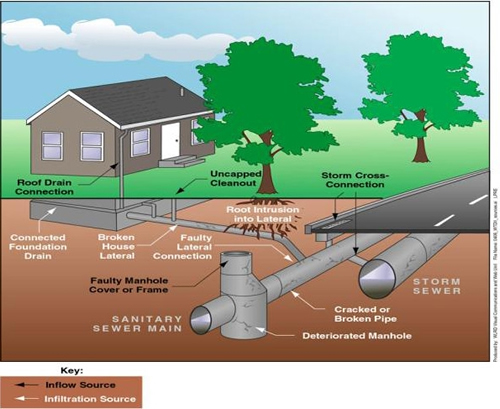Frequently Asked Questions
Inflow and Infiltration I&I Questions
Emergency Questions
-
Sewer is backing up in my residence or business, what should I do?
Please contact MetroConnects immediately at 864-277-4442. To see how you can help prevent this happening, please click here.
-
There is sewage running out of a manhole or a clean-out.
Please contact MetroConnects immediately at 864-277-4442.
-
I have a bad odor in my house that smells like sewer.
Check all traps in your home and run water in all fixtures. If these steps do not work, you will need to contact a plumber and/or contact MetroConnects at 864-277-4442 with questions.
Important Questions
-
What do I need to do before I dig on my property?
- Contact South Carolina Call 811 Before you Dig by dialing 811 to submit a locate request.
Click here for more information or select to submit a request now.
Please contact MetroConnects at 864-277-4442 with questions.
-
Does Taylors pump out septic tanks?
No. Please contact MetroConnects at 864-277-4442 with questions.
-
My septic tank has failed and there is sanitary sewer service available to my property. Can I repair my septic tank?
Please contact MetroConnects at 864-277-4442 with questions.
-
How much does a sewer connection cost?
To view MetroConnects’ Sewer Fee Schedule, or to apply for a sewer permit, please click here.
-
Can Taylors issue a Renewable Water Resources (ReWa) permit as well?
Please contact MetroConnects at 864-277-4442 to inquire if MetroConnects is authorized to issue a permit on behalf of Renewable Water Resources.
-
What types of payment does Taylors Fire and Sewer District accept?
We can accept cash, check, or credit card payments. Please make all checks payable to Taylors Fire and Sewer District. If paying by credit card, please note that a 3% fee will be assessed.
-
Can you locate a main line on my property?
Please contact MetroConnects at 864-277-4442 with questions.
What is rehabilitation?
Rehabilitation is employed when a section of the sewer collection system fails, resulting in excessive infiltration/exfiltration problems. There are several repair methods available. The choice of method or combination of methods depends on the physical condition of the sewer system components (i.e., pipeline sections, manholes, and service connections) and the nature and magnitude of the problems. If the problem does not involve the structural integrity of the system’s components or the need to increase the capacity of the existing system, rehabilitation can be an effective way of restoring the utility of the failed system component.
General Questions
-
What is a main line?
A main line is a pipe usually in the street or right-of-way which collects and carries sewer to the Treatment Plant for treatment. These are the pipes which service all residential and business areas and carry wastewater from the connected laterals to the wastewater treatment plant. They will be the pipes that connect to manholes you frequently see about our streets and other areas.
-
What is a manhole and where would it be located?
 Manholes are openings in the sewer system used to access underground sewer line infrastructure. Manholes are typically round and usually located in the road or in a right-of-way. Manhole lids are generally 24″ in diameter.
They are sometimes also known as access holes or maintenance holes. You may see raised manholes in right-of-ways.
Manholes are openings in the sewer system used to access underground sewer line infrastructure. Manholes are typically round and usually located in the road or in a right-of-way. Manhole lids are generally 24″ in diameter.
They are sometimes also known as access holes or maintenance holes. You may see raised manholes in right-of-ways.
-
What is a service line (lateral line)?
A service line is an individual residence or business’s sewer pipe which carries sewer from your house or business to main sewer pipe.

Click image to see a larger version.
• What is a private sewer system (or satellite sewer system)?
A private sewer collection system is a system which is not owned or maintained by a Sewer District. They are usually more complex and elaborate than simple private service lines since they contain manholes and main lines. Private collection systems are owned and maintained by individuals, firms, homeowner’s associations, apartment complex, or other such private entities. Click here for the EPA Homeowner’s Guide to Septic Systems or Click here to learn more from DHEC about septic tanks
-
What is a wastewater collection system?
A wastewater collection system is a series of pipes which branch out from one another like branches of a tree. Major trunk lines are generally larger and can carry more capacity, like the “trunk” of a tree, with mainlines branching out and making up the majority of the collection system. Connected to the mainlines are service/lateral lines which are connected to personal homes or commercial businesses. These pipes can be found in the street or right-of-way/easement and are designed to transport wastewater from sanitary fixtures (toilets, sinks, bathtubs, showers and lavatories) inside your house or place of business to sewage treatment plants for treatment.
A clean-out is an opening in the wastewater collection system used to access the customer’s service line for cleaning or clearing blockages. They are usually located near the public right-of-way or next to the house/structure. Some clean-outs will have a metal cover over them to protect them from getting broken. To request a Sewer Clean-Out Inspection with MetroConnects, please click here.
-
What is a back-flow valve and who installs it?
A back-flow valve can greatly reduce your possibility of a sewer back up into your home or business. A back-flow valve is a fixture installed into a service line to prevent sewer back-flows. Please contact MetroConnects at 864-277-4442 with questions regarding the installation of back-flow valves.
A right-of-way or easement is a right to use the land of another in some limited way that does not amount to full ownership of the land. Right-of-ways grant the right and privilege of entering private property to construct, maintain, and operate the components of a wastewater collection system. Please contact MetroConnects at 864-277-4442 with questions regarding right-of-ways.
• What is PCB?
Recently, several water resource recovery facilities in the Upstate of South Carolina have been affected by illegal dumping of PCB’s (polychlorinated biphenyls). PCBs are chemicals that were used as coolants and lubricants in transformers, capacitors and other technical equipment and were banned from production by Congress in 1979. If you have any knowledge or suspect anyone of illegally disposing of hazardous materials, such as PCBs, arsenic, cyanide, pesticides, herbicides or metals please contact Crime Stoppers at 1-864-23-CRIME or ReWa at 864-299-4000. Click here for printable PDF.
Inflow is stormwater that enters into sanitary sewer systems at points of direct connection to the systems. Various sources contribute to the inflow, including footing/foundation drains, roof drains or leaders, downspouts, drains from window wells, outdoor basement stairwells, drains from driveways, groundwater/basement sump pumps, and even streams.
Infiltration is groundwater that enters sanitary sewer systems through cracks and/or leaks in the sanitary sewer pipes. Cracks or leaks in sanitary sewer pipes or manholes may be caused by age related deterioration, loose joints, poor design, installation or maintenance errors, damage or root infiltration. Groundwater can enter these cracks or leaks wherever sanitary sewer systems lie beneath water tables or the soil above the sewer systems becomes saturated.
-
Why is inflow and infiltration a problem?
Sanitary sewer systems are designed to carry wastewater from toilets, dishwashers, sinks, or showers in homes or businesses. Inflow and infiltration add clear rain or ground water to sewer systems increasing the load on the systems. Clear water belongs in stormwater systems or on the surface of the ground, and not in the sanitary sewers. A stormwater system is designed to carry rainwater away, and is normally much larger than sanitary sewer systems because it is designed to carry larger amounts of water. When stormwater enters sanitary sewer systems, it must be transported and treated like sanitary sewer. During dry weather the impact of inflow and infiltration can vary from minimal impact to a significant portion of the sewer pipe flow. Wet weather magnifies existing inflow and infiltration sources. As a rain event begins the inflow and infiltration sources start filling the sanitary sewer systems with clear water, eventually filling the sewer systems to capacity. Once the sanitary sewer systems have reached capacity or becomes overloaded, wastewater flows at much higher water level than normal and if sanitary fixtures or drains are below this overload level, water will flow backward through the sanitary sewer pipe, flooding basements or households and causing manholes to pop open releasing wastewater onto the street.
-
Who is Responsible for I & I Problems?
Studies show it has been found that the greatest contribution of inflow comes from private property. Inflow connections at your home may alleviate the inconvenience of flooding in your yard, it has significant impact to the sewer system, sewer rates, and public health. It has been estimated that approximately 40% of total I&I is contributed by the “private” side of the sewer. Individual sewer users can play a BIG role in minimizing sewer fees, promoting proper functioning of the sewer system (reducing spills), and protecting the environment. Your sewer agencies are spending a lot of money replacing old defective sewer lines in the streets to reduce infiltration but individual sewer users MUST do their part in reducing rainwater inflow.
-
What Can You Do to Prevent and Reduce Inflow & Infiltration?
- Know where your service line is on your property.
- Inspect your cleanout to make sure the cap is tightly closed and that the cleanout pipe has not been damaged (such as by a lawn mower). Re- place missing caps so that rainwater can not get into the sewer system.
- Disconnect outdoor patio, deck, yard, driveway, or garage drains that may be connected to the ser- vice line.
- Reroute sump pump discharges from basement or foundation drains entering service line to outdoor lawn areas or storm drains.
- Inspect the rain gutters on your home and make sure the downspouts are not connected to the sewer system. If the gutter downspouts are con- nected to the sewer line, have them disconnected. Rainwater should be redirected to rain gardens, lawns, and/or storm drains
- Repair and/or Replace broken, leaky, cracked, damaged, or problem sections of your property’s service line.
- Maintain your service line. Keep it clean and clear of any obstructions, such as roots, grease, and debris.
- Avoid planting trees and/or shrubs over or near your service line. Roots intrude into your service line causing leaks and damages.
- Contact a licensed plumber to perform a periodic inspection of your home’s service line for cracks, separated joints, or sags.
- If you have a basement sump pump to pump out groundwater or rainwater leakage, be sure that it does not connect to your service line or to a sink or floor drain in your basement.
• What are Sanitary Sewer Overflows (SSOs)?
Sanitary Sewer Overflows (SSOs) are discharges of raw sewage from municipal sanitary sewer systems. SSOs can release untreated sewage into basements or out of man- holes and onto streets, playgrounds and into streams before it can reach a treatment facility. SSOs are often caused by blockages in sewer lines and breaks in the sewer lines.
• Why do sewers overflow?
SSOs occasionally occur in almost every sewer system, even though systems are intended to collect and contain all the sewage that flows into them. When SSOs happen frequently, it means something is wrong with the system.
• Problems that can cause chronic SSOs include:
– Inflow and Infiltration (I&I)
– Undersized Systems
– Equipment Failures
– Deteriorating Sewer System• What is okay to flush?
Many materials that people frequently flush can harm the pipes that connect to the sewer system. The only thing that you should ever flush down the toilet is toilet paper. Below is a list of items that should NOT be flushed:
- “Flushable” wipes
- Paper Towels
- Cleaning rags and household wipes
- Feminine hygiene products
- Diapers
- Cat Litter
- Medical bandages
- Dental floss
- Q-tips
- Medications
For more details on how to protect your sewer system, please click here.



